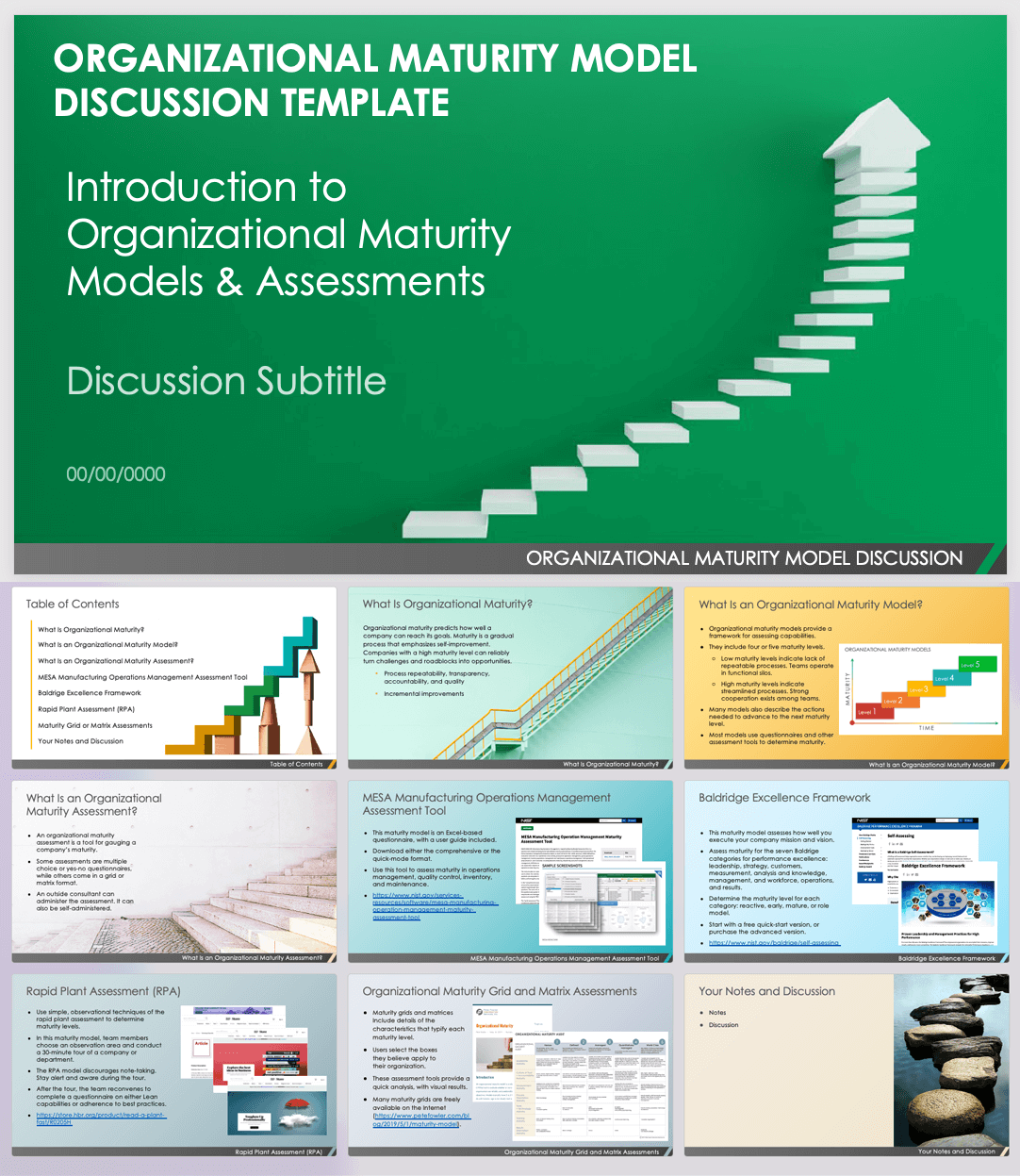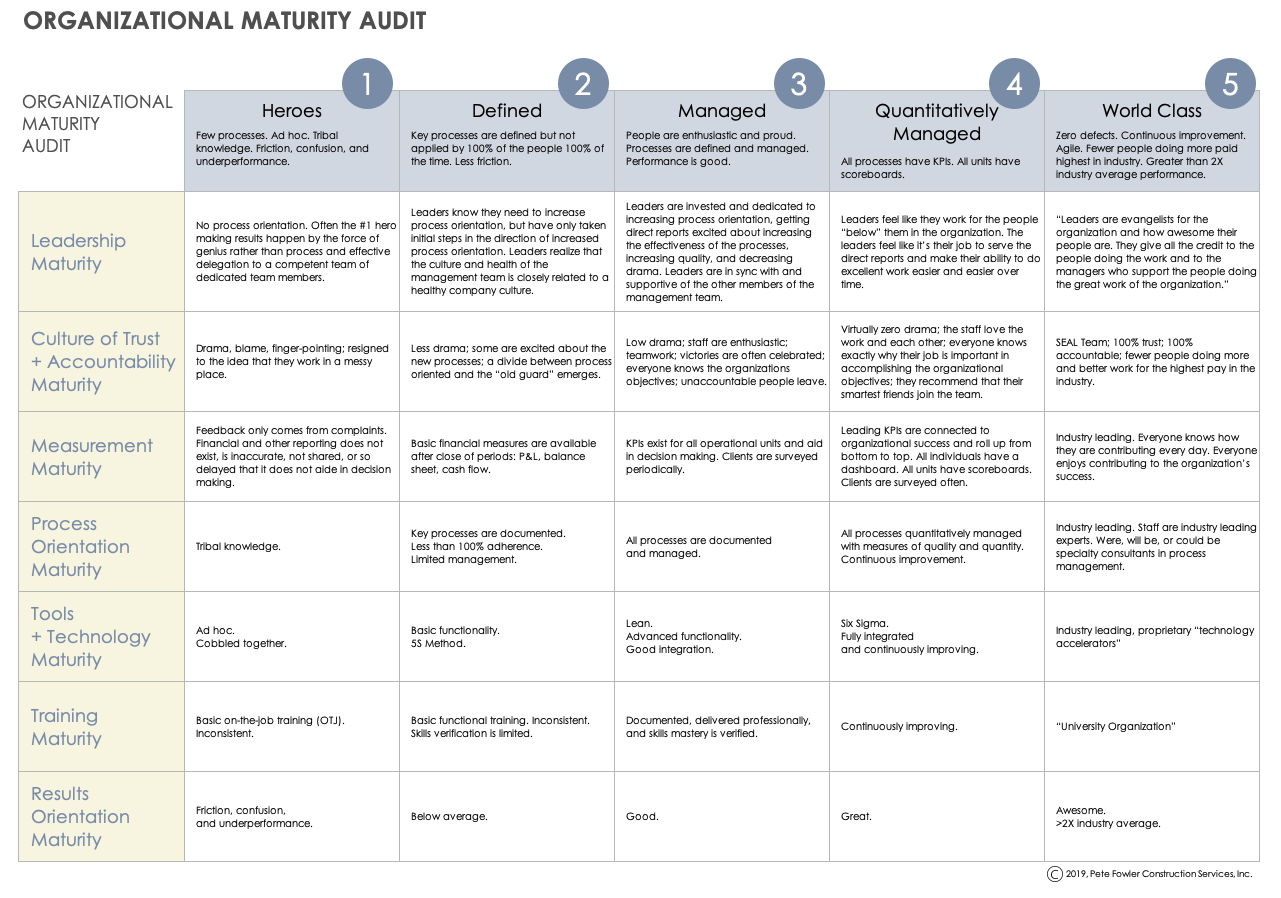What Is Organizational Maturity?
Organizational maturity is the measure of the quality of a company's operations. A company with a high maturity level is able to face challenges and seize on opportunities. Improving organizational maturity is a gradual process that emphasizes self-improvement.
“In a maturing organization, two things are happening,” says Chuck Werner, Manager of Operational Excellence at the Michigan Manufacturing Technology Center. “One, you're becoming less reactive as an organization. You’re becoming a data-driven organization, meaning that you're making decisions based on understanding performance and financial results.
“Two,” he continues, “you’re approaching what I call autonomous manufacturing. Autonomous manufacturing is not about being automated or about machines and robots. Autonomous manufacturing means having an enlightened workforce where the people closest to the problem have the information, the training, and the authority to take steps to correct a problem or seize on an opportunity. Maturity comes down to agility and building your agility to quickly counter a problem or seize on an opportunity.”
Organizational maturity is an important factor in business development and emphasizes continuous improvement for the company. As you expand your business, take on new initiatives, and build strategic partnerships, you should also work toward growing your maturity. Maturing entities are sometimes called learning organizations because they are continually adapting to changes as they grow.
What Is an Organizational Maturity Model?
An organizational maturity model is a framework for measuring a company’s maturity. Usually, these models divide maturity into levels or stages. Once company leaders understand their current organizational maturity, they can begin working toward a higher maturity level.
When projects or processes fail, it is tempting to blame faulty technology or human error. However, these projects and processes will continue to fail if the organization is not mature enough to handle the scale or complexity of their projects. Continued failure can lead employees to feel disappointed and defeated, so it is crucial that companies understand their maturity and adapt projects to their current capabilities.
Most organizational maturity models include five stages or levels, as well as a list of defining characteristics for each. These characteristics may refer to qualitative aspects of a business, such as company culture or governance structure. They may also refer to repeatable, quantifiable activities and processes.
You can apply maturity models to any size or type of organization, from large financial organizations to small nonprofits. You can also apply these models to individual departments within an organization. Whatever the company, leaders can use maturity models to identify problem areas and measure success.
Dr. Sarah Skidmore, CEO and Consultant at Skidmore Consulting, explains how different models serve different purposes. “The first question is: Where are you trying to mature?” she says. “We can use an appropriate model to benchmark and note where you are now, and where you can put work in place to grow in maturity.”
Organizational maturity models and assessments evolved from the quality and process maturity models of the 1970s and 1980s. Most maturity models used today are rooted in Carnegie Mellon Institute’s Capability Maturity Model (CMM), which was developed for measuring software development capabilities, and the Capability Maturity Model Integration (CMMI).
Various groups and individual practitioners have developed organizational maturity models, including the Object Management Group (OMG), which created the Business Process Management Maturity (BPMM) model, and the Project Management Institute (PMI), which created Organizational Project Management (OPM3).
Organizational Maturity Model Discussion Template
Download Organizational Maturity Model Discussion Template
Microsoft PowerPoint
| Google Slides
Use this free organizational maturity model discussion template as a guide to help you plan your next presentation on organizational maturity. The deck comes pre-filled with descriptions of maturity stages and assessments. Present the slides as is, or customize them with details specific to your organization.
Examples of Organizational Maturity Models
There are hundreds of maturity models that each measure different aspects of maturity. Experts have developed these models and confirmed their premises based on survey data and statistical analysis.
You can use several common maturity models to measure the maturity of your organization, including the following:
- Agile ISO Maturity Model (AIMM): Designed with Agile practices in mind, this model aims to meet the standards set out by the International Organization for Standardization (ISO). For more information and resources on Agile maturity, see this comprehensive collection of Agile maturity template.
- Organizational Project Management Three (OPM3): Developed by the Project Management Institute (PMI), this model will help you assess enterprise-wide project management maturity in program and portfolio management.
- Portfolio, Programme, and Project Management (P3M3): Owned by the UK-based Axelos, this model includes seven perspectives, or aspects of organizational maturity, and rates each on a five-level scale. The P3M3 model can measure the maturity of your portfolio management, program management, or project management..
- Project Management Maturity Model (PMMMSM): Created by PM Solutions, this popular organizational project management maturity assessment uses a five-level system to define the maturity of an organization’s project management systems and processes. For more tools to help you organize and track project management maturity, see this collection of free and downloadable project management maturity templates.
- Business Process Maturity Model (BPMM): Based on the Process Maturity Framework created at IBM in the 1980s, this model provides guidelines for standardizing organization-wide processes and increasing process maturity.
Organizational Maturity Stages
Most organizational maturity models feature five stages. The stages map a company’s possible path from enterprise chaos to industry leadership. Most organizations are at the first two levels of maturity. Not every organization needs to achieve the highest maturity level.
Here are the five most common maturity levels and their defining characteristics:
Level One: Informal
Level one, or the informal stage of organizational maturity, is also called chaotic, ad hoc, or reactive. At this stage, success depends on the efforts of individuals, or heroes, rather than on processes. Subpar coordination and communication characterize this level.
As the company scales, work can become harder to control because activities are uncoordinated. Senior leaders may plan strategically, not communicate plans well to the rest of the company, and then feel disappointed when initiatives fail.
Level Two: Defined
At level two, known as the defined stage of maturity, consistent practices emerge in silos and departments. Standards and process documentation reduce improvisational workflows. Cross-functional teams replace ad-hoc groups. Best practices, good habits, procedures, and routines take hold.
Werner marks this stage as the point when teams know what they don’t know. Companies have started to collect data, so they can develop data-based solutions and more accurately calculate cost savings. Consider levels two to three to be a starting point for significant improvement.
Level Three: Integrated
At the third maturity level, called the integrated stage, companies integrate capabilities, standardize processes, and incorporate best practices. Process changes are documented and traceable. Teams share information across departments. Employees understand and commit to the organizational vision and goals.
Employees of level three companies feel empowered to make appropriate decisions about their jobs. Roles and responsibilities are well defined, and employees participate in problem solving and brainstorming. The organization experiences less resistance to change. Automation of processes frees people and tools to focus on improvement.
Level Four: Strategic
Level four businesses, or those in the strategic stage of maturity, align processes with strategy. Teams use processes consistently and predictably across the organization and manage work through metrics. Miscommunications and interpersonal conflicts are rare.
Level Five: Fully Optimized
A level five organization, at the fully optimized maturity stage, is world class and self-optimizing. This organization is rare and sets the benchmark for similar businesses. Its optimized processes lead to efficient daily operations. Efficiency opens the way to innovation.
How to Advance to the Next Maturity Stage
Once a business identifies its goals, as well as the obstacles to those goals, it can work toward transitioning to the next maturity stage. Growing maturity means implementing processes to solve problems and meet goals, and monitoring for new problems.
Werner stresses how important assessments and measurements can be in growing an organization's maturity. “Many Lean efforts fail because companies begin to feel that they're just throwing money down a hole,” he says. “They shut down work, do all this training, and have all these events, and how does it help the company? If I don't have an understanding of benchmark performance, and a good way to measure the impact of the improvements, I can’t see it as value added.”
Companies should also find a way to quantify and prioritize problems so they don’t waste time on insignificant issues. “I may be sending people after problems that we think are critical because they're the sharp stick,” Werner says, “or it's something that really bothered me that day. But I don't know that these are the top issues driving the bottom line of my business. You really have to understand those issues before you can truly see the value in a continuous improvement program.”
Pete Fowler, Founder and CEO of Pete Fowler Construction Services, explains how, a few years ago, he realized that growth in his 15-person business had stalled. Staff assessed company maturity using a matrix Fowler created. “We made a plan to work on the things we were the worst at,” says Fowler, referencing Eliyahu M. Goldratt’s novel, The Goal: A Process of Ongoing Improvement, about the Theory of Constraints. “There's always a bottleneck. In our case, the bottleneck was at the top of the bottle. It was always me,” he quips. “I didn't know how to be a good manager, let alone a good leader, for a mature organization.”
As a result of their assessment, the company established a management team. “We’re nurturing people more than we ever have,” says Fowler, “and we have more adherence to our processes than we ever have because the processes are now being updated by the people who do the work.”
Expert Tips for Advancing to the Next Maturity Stage
Growing your organizational maturity is a gradual process that takes time. Learn from seasoned business leaders with experience growing organization maturity, from informal or integrated stages to strategic or fully optimized stages.
For example, Werner uses a four-stage maturity model, which identifies the next steps required to advance to each stage. Introducing interconnectivity, metrics, and measurements can transition a company from the first to the second level of organizational maturity. Lean and Six Sigma practices can move an organization to the third level. Standard systems lift an organization to the fourth. This example illustrates maturity levels for a manufacturing company, but the general concept applies to any business type.
Experts offer these additional tips to help you advance your organization to higher maturity levels:
- Start with Available Resources: Look at your internal resources, particularly in larger organizations, to see how you can make improvements. Only after you’ve reviewed and allocated existing resources should you turn to external resources. “I always like to tell folks: don't let money be a barrier,” says Skidmore. “Start today, even if you don't have a line item in your annual budget for it. See what steps you can take today that keep you moving in the right direction.”
- Be Open to Assessments: “The first thing that everybody has to understand about assessments is that they set a benchmark,” says Werner. “It's not a measurement of good or bad.” Making value judgments, rather than objective assessments, discourages people from addressing both positive and negative aspects of the organization. In addition, value judgments encourage silos, whereas an assessment should highlight problems that affect the bottom line for an entire organization. Use an existing measurement tool, such as Lean Six Sigma, to make your assessments.
- Commit to Growth: Maturity doesn’t happen overnight. Once you’ve identified and addressed problems, it takes time for daily operations changes to manifest in project results. Moving from one stage to the next could take three years or more. If your organization advances from stage one to stage five, expect to wait at least 8 to 10 years, and Werner notes each stage can take up to 3 years.
- Distinguish Age from Maturity: Age is not synonymous with maturity. Companies that are old and established may have problems with inefficiency and conflict.
- Use Objective Measures: You cannot gauge progress without clear metrics. “If you're implementing something or trying to make an improvement, are you treating it like a hobby or a project?” asks Werner. “Too often, people are treating it like a hobby, where it's something they don't check on.”
“Everyone, including assessors, can have blinders on about how a business really operates,” Skidmore adds. “That’s why metrics and the objective view are critical.” - Make Incremental Changes: Reassure employees that no one expects the company to go from the lowest to the highest maturity level in one giant step. Most diagrams depict maturity in steps for a reason; you lift your company gradually from one level to the next.
- Have a Clear Vision:
- Giles Johnston, Director and Co-Founder of Fraction ERP, recommends setting clear, specific goals for growing your maturity. “If you say to someone, ‘Give me a 10-year vision,’ for most people, it's just too big a question,” he says, “but if you say, ‘Where do you want your sales to be in 10 years?’ then they say, ‘All right, I want to be doing 300 million, or I want to be doing 3 million.’ You say, ‘OK, what sectors will you work in?’ ‘Yeah, I want to move from oil and gas to renewables.’ ‘OK. What else?’ ‘Well, I need to recruit a sales guy who has experience in that sector. Before I do that, I better consider the job description.’” These concrete questions help people drill down on their goals. “Suddenly,” says Johnston, “they've got a continuum they can follow for the next few years that tells them how they can mature their company.”
Common Challenges with Organizational Maturity
Many challenges can prevent organizations from improving their maturity level. Anything from unsupportive senior leaders to resource shortages to a lack of real-time data can hamper organizational maturity efforts. Anticipate common challenges so that you can address them effectively.
Lack of Support from Leadership
Skidmore explains that the first challenge to growing maturity is buy-in from top management: “You need that leadership support because a project might be two or three months, but a maturity initiative is a commitment of two to four years.
“It’s not gonna happen in six months,” Skidmore warns. “You need that buy-in across the top leaders that they’re willing to invest funding, they’re willing to invest personnel, and they're willing to invest time in supporting these efforts. If you don't have that buy-in, you can’t maximize growth and maturity. You're likely going to stay in that ad hoc or learning phase.”
Fowler agrees. “If the CEO of the business you work for doesn't care about quality,” he says, “you should leave that company, and you should do it soon. Otherwise, you're just going to be sad. Quality improvement and continual process improvement don’t work unless they come from on high.”
Lack of Human Resources
Another barrier to progress centers on human resources. If a company does not have the people to spearhead maturity growth, efforts to improve maturity will likely fail.
“Sometimes somebody gets this great idea that we need to do x, y, z better,” says Skidmore. “Well, many times, you need new programs or policies or maybe even new departments to move forward in these models. We can't just tack on those new requirements to job descriptions for folks that already have a full-time job.” You may need to hire additional personnel or contractors for support.
Lack of Data
Without solid data to support your organizational maturity efforts, it can be difficult to track results, get executive buy-in, or maintain momentum. However, modern technology should make data collection easier.
“Data collection used to be difficult because people had to log in manually, then give data to their boss, who submitted it for data entry so that a report could be created. By the time that all happened, it was the 10th of the next month, and people just realized that the prior month was bad,” explains Werner.
Now, organizations can leverage the power of operational analytics. “One of the benefits of technology-age interconnectivity is that we can make data collection the standard work of result measurement,” Werner explains. “We can ensure that people do things the way we hope they would do. Using technology these days can push us up those maturity steps that much faster.”
Poor Data Sharing
Sufficient data is only helpful when the people who need it can access it. “I don’t know how many times we put supervisors in a position where they don't have the information to make a good decision, but they have the responsibility to make a decision. They often just make one,” laments Werner. “It's not just data collection and data analytics, but sharing that information with the people who are at the point of the problem or at the point of the process where they can exert immediate control. That's the real power of putting information into the hands of the people.”
Organizational Maturity Assessment
An organizational maturity assessment is a process for determining an organization’s maturity level. Assessments may also prescribe improvement options. They appear as matrices or questionnaires, are either free or proprietary, and are available in multiple formats.
Assessment tools include maturity grids, questionnaires, checklists, and more. Questionnaires or checklists that measure maturity usually contain a Likert scale or a list of yes-no questions. Once you tally the score, a corresponding key will reveal your maturity level. Entities and subunits often self-administer free diagnostic tools, while third-party consultants usually conduct proprietary assessments.
Maturity grids, or maturity matrices, such as Fowler’s maturity audit, match maturity levels to important performance activities or characteristics. Users select the boxes with the aspects they believe apply to their organization and use the resulting image to determine maturity. Grids provide an intuitive, visual approach to analyzing a company or unit’s maturity.
Organizational Maturity Audit Template
Download Organizational Maturity Audit Template — Adobe PDF
This printable organizational maturity audit template is a maturity grid designed by Pete Fowler. Use the provided descriptions to rank aspects such as leadership, culture, processes, metrics, technology, training, and results. Print the matrix, then use colored pens or pencils to color the squares in red, yellow, or green according to how high you rate your organization's maturity for each area. Red signifies a problem area, and green shows an area of high maturity.
Organizational Maturity Assessment Questionnaires
Organizational maturity assessment questionnaires are tools that help you assess maturity. Questions might appear in different formats, including multiple choice, yes-no, or open-ended questions. Use short surveys to begin your assessment and detailed surveys for in-depth analysis.
Below are three popular organizational maturity assessment questionnaires:
- MESA Manufacturing Operation Management (MOM) Assessment Tool: This multiple-choice questionnaire in Microsoft Excel provides quick but comprehensive maturity assessments. The survey, which comes from the National Institute of Standards and Technology, measures operations management, quality control, inventory, and maintenance maturity. Users can use this quick-mode assessment to identify low-maturity areas in a comprehensive evaluation. This assessment assigns a maturity level from zero to five.
- Baldrige Excellence Framework: Use the Baldrige assessments to determine if you have a solid systematic method for managing your organization. This framework helps you assess your organization’s systems outlook, the consistency and output quality of your processes, and how well you fulfill your vision, mission, and goals. These assessments measure maturity for each of the seven Baldrige categories for performance excellence: leadership; strategy; customers; measurement, analysis, and knowledge management; workforce; operations; and results. For each category, you can assign one of four maturity levels: reactive, early, mature, and role model.
Begin with Are We Making Progress?, a preliminary assessment that you can customize to your workplace. For a more detailed evaluation, choose the free Baldrige Excellence Builder or the purchased Baldrige Framework guide. - Rapid Plant Assessment (RPA) Process: This maturity assessment, created by R. Eugene Goodson of the University of Michigan Ross School of Business, is a quick and accurate way to gauge maturity and capability in a manufacturing setting.
The RPA is a 30-minute assessment. A small team trained in RPA visits their own plant or a competitor’s. Each team member decides on a focus area before the tour. They look for visual cues and ask employees questions. The RPA method discourages note-taking because it can distract these team members from making observations. Afterward, the team meets to complete the questionnaires. One questionnaire assesses leanness, while the other gauges best practices.
What Is a Mature Organization?
A mature organization efficiently and effectively adapts to change. Everyone follows documented processes. This compliance reduces waste and discord. Employees feel empowered to make job-related decisions. Finally, a mature company is always working to improve itself.
Usually, a mature organization will be at the fourth or fifth level of maturity. Companies with this high level of maturity will have streamlined processes in place to make continuous, incremental process improvements. Werner explains that you can recognize a mature organization when its employees feel empowered to seek answers to problems independently, without prompting from management.
On the other hand, a company with low maturity will not have these processes in place. There will be poor communication between team members and departments, and management will emphasize immediate results over long-term growth. “Clients will come to us and say, ‘Hey, we don't have a leadership development program. We need something right now,’” says Skidmore. “I can tell you right there — they're in the ad hoc phase.”
Benefits of Becoming a Mature Organization
High organizational maturity means higher efficiency and effectiveness. Better communication, alignment on goals, and streamlined processes all increase employee morale. Business leaders are able to adapt to challenges, and employees are empowered to solve problems independently.
Fowler also emphasizes that maturity encourages a culture of continuous improvement. “Entropy is a very real thing,” he says. “And whether it's in physics or with human organizations, if something’s not continually refreshed, it will degrade. Either you are continually improving and stumbling forward, or you're going backward.” As a company, you have to identify and overcome inefficiency and ineffectiveness if you want to expand and innovate.
Other benefits of becoming a mature organization include the following:
- High Productivity: By eliminating redundant and inefficient processes, companies increase overall productivity.
- Increased Agility: Companies can adapt to market changes and pivot when there are challenges or setbacks.
- Increased Customer Satisfaction: Business relations improve overall.
- Reduced Costs: Increased visibility into spending lowers costs.
- Reliable Data: Shared information means fewer rumors and conjectures and higher quality data.
Optimize Your Organizational Maturity with Smartsheet
Empower your people to go above and beyond with a flexible platform designed to match the needs of your team — and adapt as those needs change.
The Smartsheet platform makes it easy to plan, capture, manage, and report on work from anywhere, helping your team be more effective and get more done. Report on key metrics and get real-time visibility into work as it happens with roll-up reports, dashboards, and automated workflows built to keep your team connected and informed.
When teams have clarity into the work getting done, there’s no telling how much more they can accomplish in the same amount of time. Try Smartsheet for free, today.





